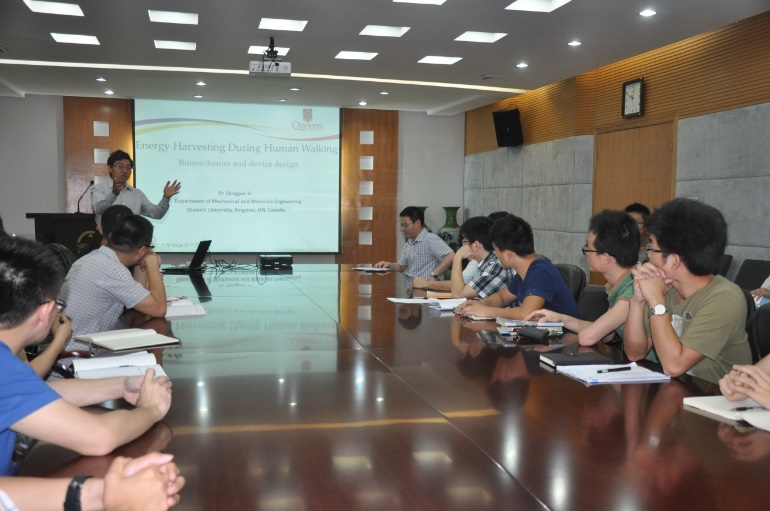At the invitation of Professor Liu Tao from the Institute of Mechanical and Electronic Control Engineering of Zhejiang University, Li Qingguo, Associate Professor of the Department of Mechanical and materials engineering at the Queen's University of Canada, gave a wonderful academic report to the teachers and students of the school. The report titled “Energy harvesting during human walking: biomechanical analysis and equipment development" Electrical, deputy director Professor Ju Bing-Feng presided over the meeting, Professor Liu Tao and more than 20 students from different institutions attended the meeting. The report was held on the morning of June 18th in the conference room on the fourth floor of the hydraulic building in Yuquan Campus.

Professor Li started with the background of equipment development. When developing the laptop energy harvester, a variety of equipment and devices have been used to collect energy in human motion, such as crank, bicycle power generation, and a winding flashlight, but one outstanding problem is that many devices require deliberate movement of the human body, which limits power generation time and power. However, the use of biomechanical energy harvesters allows energy to be collected during the daily activities of the human body, resulting in significantly longer power generation times. A typical example is a Swiss watch that is automatically wound up. There are many similar energy harvesting devices that use an external load to drive the generator. A successful example is a spring-loaded energy harvesting backpack that converts the linear motion of the backpack into a rotary motion of the electromagnetic generator, but the backpack weighs about 30kg and is mainly used in the military; another example uses the inertia of the human body. Energy is collected in the compression of the sole.
Professor Li developed a knee energy harvester capable of collecting large amounts of energy without affecting human walking. Professor Li fully studied the gait of the human body and obtained the angular velocity, force and moment curves of the ankle, knee and hip joints of the human leg through the processing of experimental data. After repeated analysis and comparison, it was found that the knee joint of the human body is most suitable for collecting energy during walking. Moreover, in the four stages of knee motion, the knee joint in the"knee extension" stage has a large speed and a large torque and can collect the most energy. At the same time, during the last period of the phase, the knee flexor muscle will do negative work so that the calf speed is reduced and stopped. The lap energy harvester cleverly uses this to detect the movement of the knee joint through the sensor. When moving to the “knee extension” phase, the clutch connects the input shaft to the shifting wheel train and begins to collect energy. In the process, the energy harvester provides negative work to help the human muscles stop the calf from turning outwards, and when moving to other stages, the clutch is disengaged. The end result is that the human body consumes almost the same amount of metabolic energy to convert it into electrical energy, the generating power of which is about 5W.
After the lap energy harvester achieved great results, Professor Li did not settle down on the status but designed and developed his own energy harvesting backpack for the shortcomings of the knee energy harvester to tie the three-dimensional motion of the knee to the plane. The device is designed to be very lightweight and in the form of a backpack, so that the center of gravity of the device is closer to the center of gravity of the human body, reducing the energy consumption of the load device. In addition, the use of large-scale motion generation at the distal end of the human body enables power to be further improved. At the same time, no other devices are installed on the legs, and the backpack is only connected to the heel by the conveyor belt, which reduces the restraint on the human body and the influence on walking. The design of the mechanism is also very subtle, the movement of the left and right legs can coordinate with each other and help the equipment work.
Finally, Professor Li mentioned his latest research, which is the use of inertial sensors to measure kinematic data in human walking. It is closely related to the research topic of Liu Tao, which is expected to replace the mature one in a decade. High-speed camera motion capture system makes measurements no longer limited to the lab.

The report came to an end. Professor Li had a question-and-answer interaction with teachers and students. Also, he had an interesting discussion on the principles of experimentation, energy harvesting on animals, and welcomed students to communicate after the meeting via email. This report ended in a strong learning atmosphere.

